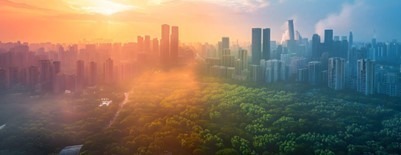The Urban Heat Island (UHI) effect is a widespread issue impacting numerous individuals worldwide. Cities tend to experience significantly higher temperatures than their rural surroundings, which has a considerable impact on the health and quality of life for urban residents (Mohajerani et al, 2017). Urban areas often create “heat islands” by replacing natural landscapes with heat-absorbing surfaces such as pavement and buildings. This phenomenon leads to increased energy consumption for cooling, higher levels of air pollution, and a rise in heat-related illnesses and deaths. Certain populations including those based on age, race, income, and geographic location, are more vulnerable to extreme heat events. The introduction of green infrastructure, such as vegetation, into urban environments can help counteract the heat island effect and provide cooling benefits to communities (EPA, 2015).
Causes of Urban Heat Islands:
One of the main causes of Urban Heat Islands is reduction of natural environments in cities. Air cooling is facilitated by trees, plants, and water features through shading, leaf transpiration, and surface water evaporation, respectively. In contrast, urban areas with hard, arid surfaces like rooftops, pavements, streets, buildings, and parking areas offer less shade and moisture than natural settings, thus contributing to elevated temperatures. Another cause of the UHI effect is the rapid urban construction and characteristics of material used. Common artificial materials used in city environments, such as paving or roofing, tend to absorb and emit more solar heat while reflecting less solar energy compared to vegetation, trees, and other natural surfaces. Heat islands often intensify throughout the day and become more pronounced after dusk as urban materials gradually release the heat they’ve absorbed. Moreover, the size and layout of buildings within an urban area can impact wind patterns and the capacity of urban materials to absorb and release solar energy. In densely developed regions, surfaces and structures obstructed by adjacent buildings become substantial thermal masses that struggle to dissipate heat effectively. Cities with narrow streets and tall buildings create urban canyons, which can impede natural wind flow that would provide cooling effects. In addition. heat generated by automobiles, cooling systems, buildings, and industrial facilities all contribute heat into the urban environment. These sources of human-generated, or anthropogenic, waste heat can exacerbate heat island effects (US EPA, 2014).
The abundance of builtup surfaces with high heat capacities, such as concrete and asphalt, is one of the primary causes of UHI effect (Akbari et al. 2001). In addition, climate and topography play crucial roles. Calm, clear weather conditions intensify heat islands by maximizing solar energy absorption by urban surfaces and minimizing heat dissipation. Conversely, strong winds and cloud cover help mitigate heat island formation. Geographical features can also impact the heat island effect. For instance, nearby mountains can obstruct wind from reaching a city or create wind patterns that funnel through an urban area (US EPA, 2014). Other significant factors contributing to UHI include the use of low albedo materials, human activity, increased air conditioner use, tree destruction, urban canopy formation, wind blockage, and air pollutants (Nuruzzaman, 2015).

Fig.1. Heat Island Effect Diagram. Source: (US EPA, 2014).
Daily fluctuations in surface temperatures are generally more pronounced than those of atmospheric air, although they tend to align at night. Water bodies, such as ponds, show less temperature variation throughout the day and night, as evidenced by the fluctuations in surface temperatures. This is because water absorbs solar energy differently than constructed environments and paved areas. Urban heat can be mitigated by the presence of parks, undeveloped land, and water bodies, which create cooler zones within cities. The outskirts of cities, where suburban areas transition to rural landscapes, typically experience lower temperatures compared to central urban districts (US EPA, 2014).
Strategies to Mitigate the Urban Heat Island Effect:
The introduction of trees and vegetation has a significant cooling impact. Although space may be scarce in certain areas, communities can incorporate small-scale green infrastructure into unused grassy or bare spaces, empty plots, and along street corridors (EPA, 2015). Implementing light-reflecting coatings to the surfaces of roofs, roads, and building exteriors can be an effective strategy. Increasing the number of temperature-controlled public areas is another approach to mitigating urban heat. Moreover, constructing new buildings with diverse heights to improve air flow and create shaded corridors in urban areas is essential. Integrating more energy-efficient cooling strategies into architectural designs is also necessary (National Integrated Heat Health Information System, n.d.). In addition, incorporating green roofs is an effective strategy for reducing the heat island effect, providing both direct and ambient cooling benefits. Green roofs also improve air quality by lowering temperatures, absorbing pollutants, and preventing additional air pollution (EPA, 2015). Lastly, introducing reflective materials for roofing and cool pavements have also resulted in lowering heat absorption.
As climate crisis deepens, addressing the urban heat island effect will be vital for making cities more livable and sustainable. By combining urban innovation with natural solutions, cities can tackle this invisible yet powerful challenge and create more resilient urban environments.
المراجع:
Mohajerani, A., Bakaric, J. and Jeffrey-Bailey, T. (2017) “The urban heat island effect, its causes, and mitigation, with reference to the thermal properties of Asphalt Concrete”, Journal of Environmental Management, 197, pp. 522–538. doi:10.1016/j.jenvman.2017.03.095.
EPA (2015). Reduce Heat Islands | US EPA. [online] US EPA. Available at: https://www.epa.gov/green-infrastructure/reduce-heat-islands.
Akbari, H., Pomerantz, M., & Taha, H. (2001) “Cool surfaces and shade trees to reduce energy use and improve air quality in urban areas”, Solar energy, 70(3), pp. 295-310.
Nuruzzaman, Md. (2015). “Urban Heat Island: Causes, Effects and Mitigation Measures – A Review” International Journal of Environmental Monitoring and Analysis. 3 (2), pp. 67-73. doi: 10.11648/j.ijema.20150302.15
US EPA. (2014). What Are Heat Islands? | US EPA. [online] Available at: https://www.epa.gov/heatislands/what-are-heat-islands.
National Integrated Heat Health Information System (n.d.). Urban Heat Islands. [online] www.heat.gov. Available at: https://www.heat.gov/pages/urban-heat-islands.





